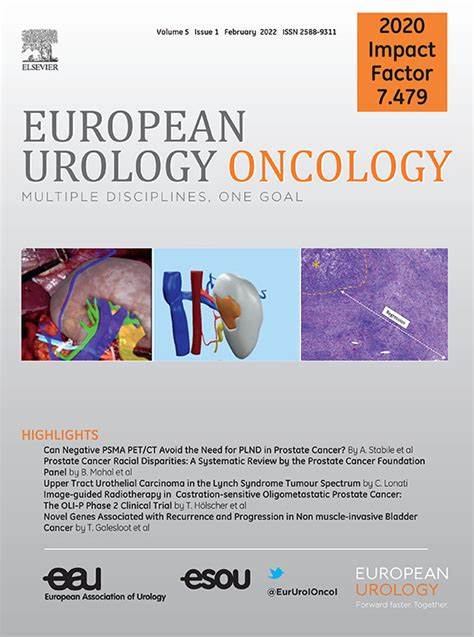Pooled Analysis of the SOLAR and SATURN Clinical Trials Comparing Progression of Synchronous Versus Metachronous Prostate-specific Membrane Antigen–defined Oligometastatic Prostate Cancer Following Systemic and Tumor-directed Therapy
IF 9.3
1区 医学
Q1 ONCOLOGY
引用次数: 0
Abstract
Multimodal strategies combining primary and metastasis-directed therapy (MDT) with short-term intensified systemic therapy may improve outcomes in oligometastatic castrate-sensitive prostate cancer (omCSPC) while minimizing long-term toxicity. This post hoc analysis of two prospective phase 2 trials, SOLAR (NCT03298087) and SATURN (NCT03902951), evaluated oncologic outcomes in prostate-specific membrane antigen positron emission tomography–defined synchronous and metachronous omCSPC (≤5 M1a–b lesions), respectively. All patients received 6 mo of intensified systemic therapy (leuprolide, abiraterone acetate with prednisone, and apalutamide) and stereotactic body radiotherapy to oligometastases. SOLAR patients were treatment-naïve and also underwent radical prostatectomy (RP) or definitive prostate-directed radiotherapy (dRT). SATURN enrolled patients with post-RP recurrences: among the 26 patients who completed protocol therapy, 12 (46%) had prior androgen deprivation therapy (ADT), six (23%) had prior MDT, and 17 (65%) had one to three prior recurrences. The primary endpoint for both studies was prostate-specific antigen (PSA) response, defined as <0.05 ng/ml after RP or <2 ng/ml after dRT at 6 mo after testosterone recovery (≥150 ng/dl). Secondary endpoints included progression-free survival (PFS) and eugonadal PFS starting from the time of testosterone recovery. Progression was determined biochemically using PSA thresholds of ≥0.05 ng/ml for post-RP and ≥2 ng/ml for post-dRT patients. Among 50 patients (24 synchronous and 26 metachronous), the synchronous omCSPC group had a significantly higher PSA response rate (83% vs 50%; p = 0.018) and significantly longer PFS and eugonadal PFS (p < 0.05). The metachronous subgroup with prior ADT had worse outcomes, suggesting increasing resistance with repeated systemic therapy.
SOLAR和SATURN临床试验的合并分析,比较同步和异时性前列腺特异性膜抗原定义的少转移性前列腺癌在全身和肿瘤定向治疗后的进展。
将原发性和转移性治疗(MDT)与短期强化全身治疗相结合的多模式策略可以改善少转移性去势敏感前列腺癌(omCSPC)的预后,同时将长期毒性降到最低。这项对SOLAR (NCT03298087)和SATURN (NCT03902951)两项前瞻性2期试验的回顾性分析,分别评估了前列腺特异性膜抗原正电子发射断层扫描定义的同步和异时性omCSPC(≤5个M1a-b病变)的肿瘤学结果。所有患者都接受了6个月的强化全身治疗(leuprolide,阿比特龙醋酸酯与强的松和阿帕鲁胺)和立体定向体放疗,以治疗少转移灶。SOLAR患者为treatment-naïve,并接受根治性前列腺切除术(RP)或最终前列腺定向放疗(dRT)。SATURN纳入了rp后复发的患者:在26名完成方案治疗的患者中,12名(46%)患者既往接受过雄激素剥夺治疗(ADT), 6名(23%)患者既往接受过MDT, 17名(65%)患者既往有1至3次复发。两项研究的主要终点都是前列腺特异性抗原(PSA)反应,定义为
本文章由计算机程序翻译,如有差异,请以英文原文为准。
求助全文
约1分钟内获得全文
求助全文
来源期刊

European urology oncology
Multiple-
CiteScore
15.50
自引率
2.40%
发文量
128
审稿时长
20 days
期刊介绍:
Journal Name: European Urology Oncology
Affiliation: Official Journal of the European Association of Urology
Focus:
First official publication of the EAU fully devoted to the study of genitourinary malignancies
Aims to deliver high-quality research
Content:
Includes original articles, opinion piece editorials, and invited reviews
Covers clinical, basic, and translational research
Publication Frequency: Six times a year in electronic format
 求助内容:
求助内容: 应助结果提醒方式:
应助结果提醒方式:


